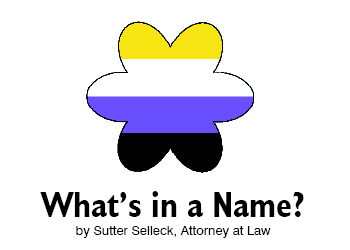What’s in a Name?
 My name is Sutter Selleck. My name was Summer Selleck. I began my gender transition quietly in May 2019. My preferred pronouns are “they/them,” no longer “she/her,” and, despite my wonderfully-full beard, not “he/him.” I identify as gender non-conforming; quite simply, I don’t feel any more related to one gender or the other. I would rather be referred to as Attorney Selleck rather than any pronoun, as any other counsel who should be so identified as just that, and not as gendered.
My name is Sutter Selleck. My name was Summer Selleck. I began my gender transition quietly in May 2019. My preferred pronouns are “they/them,” no longer “she/her,” and, despite my wonderfully-full beard, not “he/him.” I identify as gender non-conforming; quite simply, I don’t feel any more related to one gender or the other. I would rather be referred to as Attorney Selleck rather than any pronoun, as any other counsel who should be so identified as just that, and not as gendered.
I legally changed my name to Sutter and my gender to X on June 25, 2021. In recent years, name changes associated with gender confirmation have been “streamlined” by the courts. Specifically, a person no longer needs to publish their request for a name and gender change in a newspaper, and a hearing is not required. The process of achieving an order from the court to change my name and gender was not very difficult to navigate.
There is an unstreamlined process, however, of obtaining the rest of a person’s identification documents thereafter. It took almost two years from start to finish to finally receive an updated social security card, driver’s license, passport, and birth certificate. The mere fact it took me—as a lawyer—that long to change my name and gender on legal documentation should signify that a simple name change is not, in fact, so simple.
Changing my name on paper, however, was far easier than changing my name among people. Although the process of legally changing my name on documentation took time to accomplish, adapting to the changes in my practice and in my relationships with colleagues, client and the court is ongoing.
There were positives. I have had colleagues reach out to me to ask how they can best support me. Others have reached out to understand the protocol for including me in gendered projects, even though I identify as nonconforming.
There were challenges. I have had clients not want to work with me because of my gender identity. I was systematically removed from leadership in a women’s organization because I no longer presented as female. I have clarified my gender in open court, yet still had an opposing party try to upset me by referring to me as “she” throughout the proceedings. Worse yet, I have been called “it,” “tranny,” “disgusting,” and other derogatory names to which no one should be denigrated.
There were moments of grace. An opposing counsel with whom I have not had a seamless professional relationship came to my defense in a deposition when I was repeatedly referred to by his client as she, Mrs., and Miss; right as I was going to stand up for myself, he took the initiative. It made me feel seen. Many people, including members of our legal community, have opened up to me about loved ones that are trans. Clients have had me speak to their family members about trans issues.
I have been pleasantly surprised by many of the responses from our legal community. I have had some trying responses, too. Reactions wildly vary. At its core, however, I believed when I started this process, and I continue to believe, that my gender is not relevant to my work as a lawyer. I identify, simply, as a person who is an attorney.